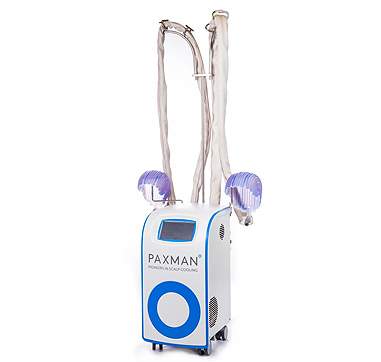
SCALP COOLING SYSTEM is the only proven technology to avoid or reduce the most feared Chemotherapy induced hair loss (Alopecia) in solid tumors such as Ovarian, Breast, Colorectal and many other. MGCH&RI is the first hospital in the state of Andhra Pradesh to introduce this facility. The rate of hair retention by using this scalp cooling system vary from patient to patient and dependent upon the chemotherapy regimen. It is important for patients to continue with scalp cooling at each chemotherapy session to get the full benefit and without any increased risk of getting cancer back.

- Vasoconstriction
- Scalp Cooling
- Reduced Metabolic activity in hair follicle
- Minimises hair loss
Why Scalp Cooling?
- Chemotherapy induced Alopecia causes
- Traumatic and distressing Psychological side effects
- Constant reminder of the disease
- Negative changes in body image
- Decreased social activity
- Altered interpersonal relationship
- Refusal to accept treatment
Besides the initial diagnosis of cancer itself, Alopecia or Hair loss continues to be the most traumatic and distressing psychological side effect that many cancer patients will experience. Alopecia is seen as a constant reminder of their disease and can cause negative changes, decreased social activity and altered interpersonal relationship. These practical and emotional problems can result in a patient’s reluctance to accept treatment. The Paxman scalp cooling system is designed to minimise or greatly reduce the degree of hair loss.
How does Scalp Cooling work?
Scalp cooling works by lowering the temperature of the head and scalp immediately before, during, and after the administration of chemotherapy. This in turn reduces the blood flow to the hair follicles, thus minimizing hair loss.
Is it effective?
Be realistic in your expectations. There are no guarantees. Scalp cooling doesn’t work for everyone. It’s frustrating, but it’s true. It would be wonderful if you didn’t have to lose a single hair while scalp cooling, but realistically that is not what is going to happen. Shedding will vary from person to person and from drug to drug. Be realistic, but positive – most drug regimens administered without scalp cooling would leave you without a single hair on your head. Studies conducted worldwide including India showed that majority of the patients undergoing scalp cooling will retain between
What preparation should you undergo before Scalp Cooling?
- Wash the hair with shampoo on the day of chemotherapy administration.
- Applying little conditioner would help in scalp cooling
- Don’t use hair pins or any sharp object while undergoing scalp cooling
- Communicate to the nurse about the cap fitment.
- Don’t oil your hair.
Can you take a break during Scalp Cooling
- Yes. Please call your nurse, ensure the coolant lines are disconnected
- Please do not get up abruptly. This could damage the connections.
- Make sure that you are wearing the cap even during the break.
- Also make sure that you return in 8 minutes and lines are connected back to the machine
What precautions should you take after Scalp Cooling?
- Do not oil/shampoo your hair for 7 days post scalp cooling
- Gently rinse hair with normal water without shampoo or conditioner for 2-3 days post scalp cooling
- Gently comb your hair. Do not use any pressure. Preferably use wide spaced comb or use your fingers.
- Do not use hair dryer. Allow your hair to dry naturally.
- Do not use very hot water.
- Do not use chemicals which contain acid.
How long it would take for each session?
Approximately 4-5 hours 30-45 minutes prior to chemotherapy. Entire chemotherapy administration time, which might vary depending on the drug. 90-120 minutes post chemotherapy administration.
When you finish your treatment wait 15 mins before removing the cap this will give it a chance to warm up and be easier to remove.
Precautions to take during Scalp Cooling
- Deep breathing
- Diverting yourself by reading a book, watching a movie or television might help
- Drink something warm
- Wear a blanket
How Scalp Cooling Works
The damage that chemotherapy causes to the hair follicle can be alleviated by using scalp cooling. It works by reducing the temperature of the scalp by a few degrees immediately before, during and after the administration of chemotherapy. This in turn reduces the blood flow to hair follicles which may prevent or minimise the hair loss.
Cooling causes blood vessel vasoconstriction, which has been shown to reduce blood flow in the scalp to 20-40% of the normal rate, resulting in less chemotherapeutic drug being delivered to the hair follicles.
The rate of drug diffusion across a plasma membrane is reduced by cooling and thus lower effective drug doses may enter the cells.
Cell division is metabolism-driven – this process is decelerated by cooling.
Also, a decrease in the metabolic activity of the cells in the hair follicle could cause a more general reduction in the cytotoxicity of chemotherapy drugs localised to the scalp.






